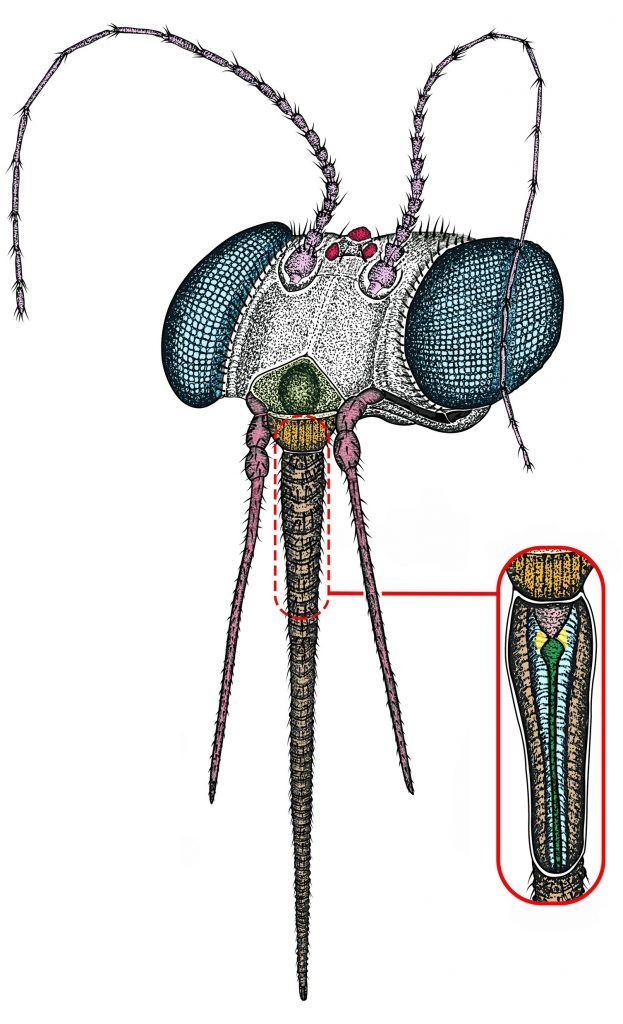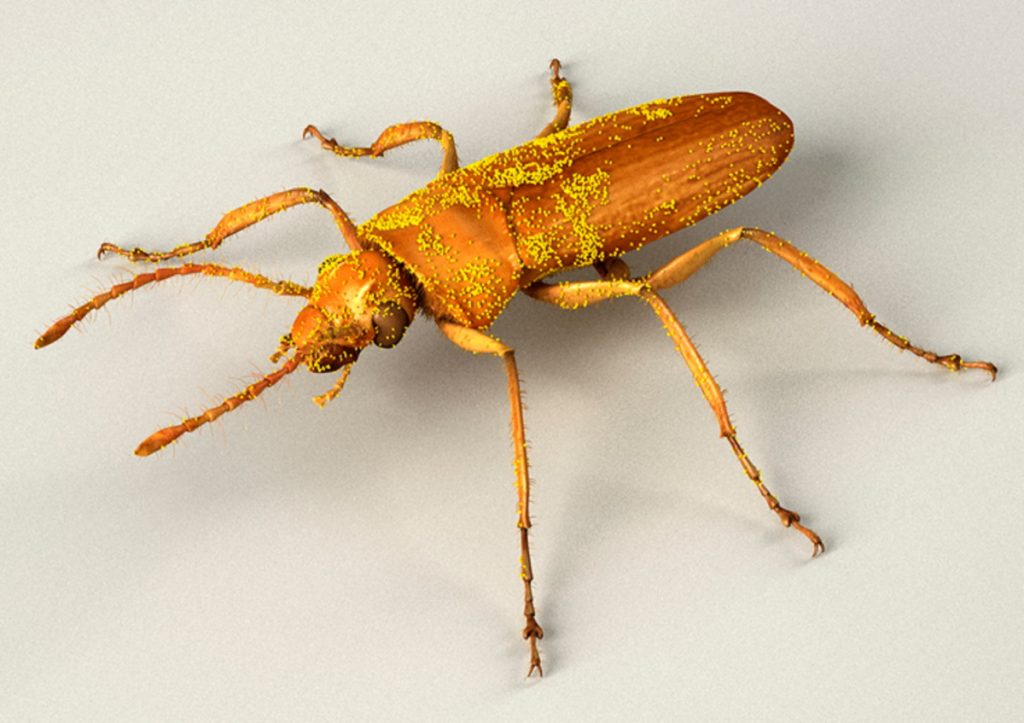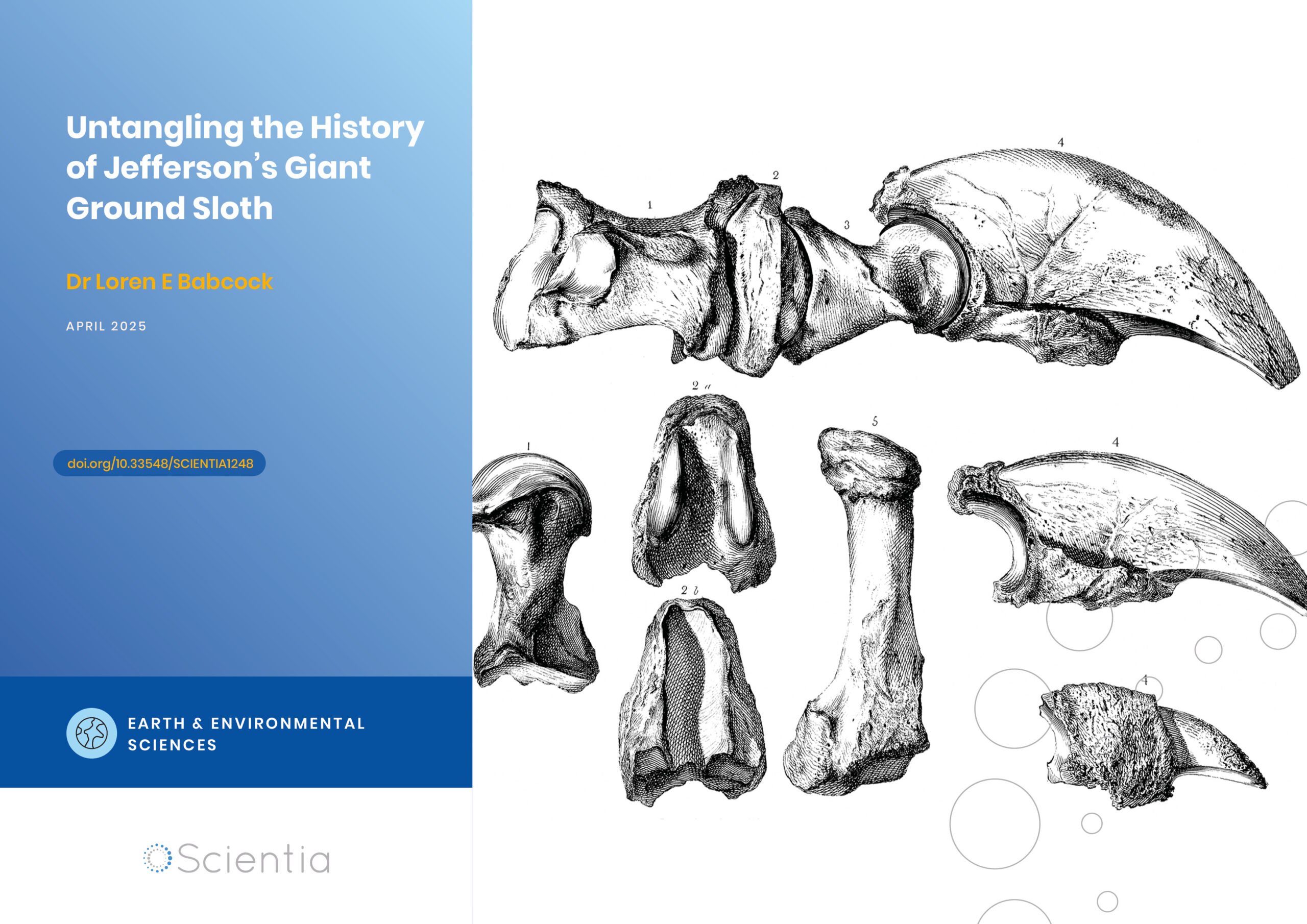Dr Conrad Labandeira – Predicting the Future of Insects by Studying Their Past
Insects are one of the most important – and ancient – groups of organisms. They were around long before dinosaurs roamed the planet and before plants evolved flowers. Fossils from millions of years ago are a priceless record of ancient insects, helping scientists to piece together the evolutionary history of modern species. Insects contained in amber and sedimentary deposits can give us valuable clues about their life histories and ecology. Smithsonian National Museum of Natural History curator and researcher, Dr Conrad Labandeira, has been examining the insect fossil record to answer important questions with implications for today’s living species.
Studying Ancient Ecosystems
A time traveller taking a trip into deep history might be astonished by the alien world that greets them. Arriving 125 million years ago during the Early Cretaceous Period, our intrepid traveller sees a world dominated by giant conifers, ferns, and ancient cycad trees, with enormous dinosaurs roaming the landscape.
On closer inspection, some familiar features are revealed – a beetle munches away at a leaf while a tiny, spined mammal scurries through the undergrowth nearby. Fast-forward by about 30 million years – forever to us, but a mere fraction of our planet’s history – would reveal a remarkably different world, filled with flowers, the earliest bees, mosquito-sized scorpionflies with long proboscises, and lizards.
Unfortunately for bold modern scientists, studying the wildlife of the past must be done without the advantage of a time machine. Fortunately, many plants and animals left evidence of their existence for us to discover, millions of years later. Fossils are like natural time capsules, preserving a record of the distant past, and one of the crowning glories of the fossil world must be amber. Insects and other invertebrates, plants, lizards, and even dinosaur feathers have all been frozen in time in the sticky tree resin and solidified into the honey and orange-coloured lumps we see today. Amber fossils can be incredibly detailed, preserving minute details perfectly in 3D. In some cases, even the colours and delicate surface ornamentation of organisms have been preserved.
The general principles governing the evolution and ecological relationships of organisms are the same across history – whether 1 year ago or 100 million years ago. For example, natural selection drives organisms to adapt to their environment over generations or the lineage will perish. Scientists can apply these principles to fossil records to build a picture of ancient ecosystems. Dr Conrad Labandeira, a palaeobiologist from the Smithsonian National Museum of Natural History, has spent most of his esteemed career doing just that.
Dr Labandeira curates the museum’s extensive insect fossil collection – over 140,000 specimens and counting – of extinct species of insects and their ancestors that lived between 410 million years ago to 11,700 years ago. However, he also travels to the far corners of the planet to find insects and their associated plants, in order to address a particular evolutionary or ecological question of the deep past.
For instance, if the question is, ‘What happened to insects and their associations with plants at the end of the Permian Period?’, Dr Labandeira travels to South Africa to study the Karoo deposits. If he wishes to investigate the development of pollination syndromes during the Jurassic and Cretaceous Periods, he travels to Northeastern China. ‘And then there is the response of insect herbivores to the Palaeocene–Eocene Thermal Maximum, a brief time of dramatic global change 56 million years ago, for which my go-to place is Wyoming, in the US,’ he says.
By applying his knowledge of taxonomy, anatomy, and ecology, he aims to understand how these species interacted with their environment, when specific adaptations evolved in insect lineages, and how insects responded to global changes. His work helps us predict how modern insect groups might respond to climate change, changes in land use, and other environmental pressures.

A long-proboscid scorpionfly.
Immortalised Insects
Like other animals, insects need a particular set of conditions to become fossilised. Their hard, external skeleton means that this occurred more frequently than for soft-bodied animals, such as worms, but their small size decreased the likelihood of fossilisation. However, in some deposits, insects occur in heightened preservation, and abundance. ‘As such, the insect fossil record is woefully incomplete overall, but is also driven by occasional and exceptional occurrences,’ says Dr Labandeira. ‘There is much still left to discover about their history.’
Amber-resin trees became more common during the Cretaceous Period, between 145 million years ago to 66 million years ago. Because amber forms from tree resin, the insects trapped in amber can reveal ancient plant-insect relationships. The evolution of insects and plants is intricately linked throughout their history, and some of the most interesting – and important – ecological events occurred during the Cretaceous Period.
In the early part of this period, from about 125 million years ago to 90 million years ago, ‘gymnosperms’ (cone-bearing plants) were replaced by ‘angiosperms’ (flowering plants) as the dominant vegetation on Earth. This switch – called the ‘Cretaceous Terrestrial Revolution’ – had profound effects on insect pollinators and herbivores. ‘The patterns of extinction, origination and continuity of insect pollinators and herbivores across this 35-million-year-long interval provide a global perspective of how insects evolutionarily and ecologically contend with a changing world,’ explains Dr Labandeira.

Left: scorpionflies on Caytonia cupules. Right: larger scorpionflies on Alvinia bohemica cone. CREDIT: Mary Parrish.
Ancient Pollinators
Dr Labandeira’s work helped answer an age-old chicken and egg question: did insect pollination or flowers come first? ‘The idea that insect pollination may have preceded the angiosperms was substantively hypothesised during the 1970s, although it was disputed,’ he says. Through extensive research, his team identified four pollination modes existing before the Cretaceous Terrestrial Revolution, based on the feeding method and mouthparts of the insect groups and the features and structures of the plants. These are fly sponging, beetle chewing, thrips punch-and-suck feeding, and siphoning through a long straw-like mouthpart element called a proboscis.
Alongside David Peris and other colleagues from Spain, Dr Labandeira examined a false blister beetle trapped in Spanish amber along with 126 pollen grains from a gymnosperm, likely a cycad species. This provides compelling evidence that this beetle’s chewing behaviour facilitated the pollination of gymnosperms before the Cretaceous Terrestrial Revolution, at which point this beetle family transitioned to angiosperm feeding. ‘This was a very rare discovery – to find a group of closely related beetles where some species are associated with gymnosperm pollen, and others are associated with angiosperm pollen in the same amber deposit,’ says Dr Labandeira.
Similarly, the researchers examined four thrips specimens covered with cycad pollen and trapped in Spanish amber. Dr Labandeira suggests that the hair-like rings flanking the wings and abdomen of these insects represent a specialised structure for carrying pollen grains, much like the branched hairs on the mouthparts and legs of modern bees.
Dr Labandeira and his colleagues and students discovered a fifth lineage of insects with long proboscises in Myanmar amber. Their studies involved anatomical examination of several specimens, including making a careful cross-section of one specimen to reveal the internal structures of the insect’s mouthparts. The scorpionfly genus, which they named Dualula, had a specialised pump system that helped it extract nectar-rich ‘pollination drops’ from the reproductive organs of gymnosperms. It lived alongside nectar-feeding moths, beetles, and flies, providing evidence that during the Cretaceous Terrestrial Revolution, there was an overlap in time when insects were simultaneously feeding on gymnosperm pollination drops and angiosperm nectar. Long proboscises evolved separately on at least 13 occasions throughout the history of mid-Mesozoic insects.
Finally, alongside colleagues from Russia and the Czech Republic, Dr Labandeira discovered an ancient fly from the early Cretaceous Period, which exhibited the sponging mouthparts and feeding behaviour we see in today’s species, such as common houseflies. The specimen they examined had pollen stuck to its face, near its mouthparts, in a pattern often seen in modern pollinating fly species.
The evidence points to specialised insect pollination evolving at some point during the Permian Period between 300 million years ago to 250 million years ago – at least 140 million years before the first flowering plants appeared. ‘Such early interactions most likely acted as an evolutionary and ecological prelude to later interactions between early angiosperms and their insect pollinators during the Cretaceous,’ explains Dr Labandeira.

False blister beetle carrying pollen. CREDIT: José Antonio Peñas.
Predicting Modern Responses from Ancient Evidence
The transition from a gymnosperm to angiosperm-dominated world had an immense effect on the resources and habitats available to insects. During the Cretaceous Terrestrial Revolution, four major evolutionary patterns occurred in pollinating insect lineages. ‘All four examples involve pollinating insects with very different mouthparts,’ says Dr Labandeira.
Some insect lineages, such as the false blister beetles, transitioned from their gymnosperm hosts to angiosperm hosts. Others, failing to adapt to their changing world, such as some ancient fly lineages, simply went extinct. Some, such as specialised thrips, persisted on their gymnosperm hosts but were greatly reduced in diversity. Finally, new insect lineages with angiosperm associations originated during this interval, such as bees.
Insects that transitioned to angiosperm hosts and those that originated with angiosperm associations flourished. Today, 85% of angiosperms are animal-pollinated, overwhelmingly by insects. Insect pollination, in turn, drove angiosperm lineages to become incredibly diverse as plants adapted and new species arose with ever-closer associations with their insect pollinators. These co-associations occasionally became co-evolved, meaning that many of today’s insects and plants are intricately linked, such as figs and fig wasps.
However, despite fluctuations in genus and species-level diversity, insect family-level diversity from 201 million years ago to 23 million years ago remained relatively stable, puzzling scientists for years. To resolve this mystery, Dr Labandeira conducted a detailed investigation of 280 plant-associated insect families from throughout this period and developed a method to control for the effects of gaps in the fossil record. Along with his other findings, this work provides evidence that the loss of some families and origination of new ones has given the appearance of family-level diversity stability.

A) Amber containing six specimens of the thrips genus Gymnopollisthrips. (B) Thrips with attached pollen grains. (C) Underside of the same specimen. (D) Drawings based on B and C, with pollen grains indicated in orange. (E) Hair-like rings (setae), and (F) magnification. (G) Ring setae showing the adherence of 12 clumped pollen grains. From Proceedings of the National Academy of Sciences, 2012, 109, 8623 doi.org/10.1073/pnas.1120499109.
For example, 95 plant-associated insect families are documented just before the Cretaceous Terrestrial Revolution, and 110 after the angiosperm explosion. Dr Labandeira demonstrated that family-level diversity of plant-associated insects plummets – an event called the ‘Aptian-Albian gap’ – and then rises again after a lag period in which insect adaptation occurs. Without examining these fine-scale changes the real patterns of diversity can be masked over sufficiently large timescales, with consequences for our understanding of today’s insect groups.
‘The history of insect diversity in deep time, which has the potential to demonstrate the impact of mass extinction, has taken on particular urgency in light of the escalating concern over a potential mass extinction of insects during the twenty-first century,’ explains Dr Labandeira. In particular, the research of Dr Labandeira and his colleague Sandra Schachat of Stanford University in California could aid predictions for how global events, such as rising atmospheric carbon, climate change, and loss of habitats might impact different insect groups based on their ecology and evolutionary history.
Dr Labandeira and his colleagues’ investigations into the gymnosperm-angiosperm transition during the Cretaceous Terrestrial Revolution previously focused on insect pollinators. To complete our understanding of this significant event, Dr Labandeira is mentoring doctoral student Lifang Xiao, and colleagues from Capital Normal University, who are currently investigating the Cretaceous Terrestrial Revolution from the perspective of insect herbivory patterns.
Reference
https://doi.org/10.33548/SCIENTIA670
Meet the researcher

Dr Conrad C. Labandeira
Department of Paleobiology
National Museum of Natural History
Smithsonian Institution
Washington, DC
USA
Dr Conrad C. Labandeira graduated with a PhD with an emphasis in Palaeobiology from the University of Chicago, after which he continued his research in a postdoctoral position in Plant Biology and Entomology at the University of Illinois at Urbana-Champaign. He has spent the majority of his esteemed career at the Smithsonian National Museum of Natural History, where he currently holds the positions of Senior Research Scientist and Curator of Fossil Arthropods. His main research interests include fossil insect-plant associations including herbivory, pollination, mimicry, and plant defences, insect evolutionary convergence and diversity, and past terrestrial food webs. Dr Labandeira has co-supervised over 36 projects by senior undergraduate, masters, doctoral, and postdoctoral researchers. He has been awarded numerous honours for research excellence and has been elected to Fellow for both the Geological Society of America and the Paleontological Society.
CONTACT
E: labandec@si.edu
W: https://naturalhistory.si.edu/staff/conrad-labandeira
KEY COLLABORATORS
Dr Mónica Carvalho, Smithsonian Tropical Research Institute, Panamá
Dr Ellen Currano, University of Wyoming, USA
Dr David Dilcher, Indiana University, USA
Dr Michael Donovan, Cleveland Museum of Natural History, USA
Dr Enrique Peñalver, Instituto Geológico y Minero de España, Spain
David Peris, University of Bonn, Germany
Sandra Schachat, Stanford University, USA
Anshuman Swain, University of Maryland, and NMNH, Smithsonian Institution, USA
Dr Yongjie Wang, Dr Xiaodan Lin, and Lifang Xiao, Capital Normal University, China
Dr Torsten Wappler, Hessisches Landesmuseum Darmstadt, Germany
Dr Peter Wilf, Pennsylvania State University, USA
Dr Bo Wang, Nanjing Institute of Geology and Palaeontology, Nanjing, China
FUNDING
Smithsonian Institution
National Science Foundation
Deutsche Forschungsgemeinschaft
FURTHER READING
X Lin, CC Labandeira, C Shih, CL Hotton, D Ren, Life habits and evolutionary biology of new two-winged long-proboscid scorpionflies from mid-Cretaceous Myanmar amber, Nature Communications, 2019, 10, 1235. doi.org/10.1038/s41467-019-09236-4
SR Schachat, CC Labandeira, ME Clapham, JL Payne, A Cretaceous peak in family-level insect diversity estimated with mark–recapture methodology, Proceedings of the Royal Society B, 2019, 286, 20192054. doi.org/10.1098/rspb.2019.2054
D Peris, R Pérez-de la Fuente, E Peñalver, X Delclòs, E Barrón, CC Labandeira, False blister beetles and the expansion of gymnosperm-insect pollination modes before angiosperm dominance, Current Biology, 2017, 27, 897. doi.org/10.1016/j.cub.2017.02.009
E Peñalver, CC Labandeira, E Barrón, X Delclòs, P Nel, A Nel, P Tafforeau, C Soriano, Thrips pollination of Mesozoic gymnosperms, Proceedings of the National Academy of Sciences, 2012, 109, 8623. doi.org/10.1073/pnas.1120499109
D Ren, CC Labandeira, JA Santiago-Blay, A Rasnitsyn, C Shih, A Bashkuev, MA Logan, CL Hotton, D Dilcher, A probable pollination mode before angiosperms: Eurasian, long-proboscid scorpionflies, Science, 2009, 326, 840. doi.org/10.1126/science.1178338

Want to republish our articles?
We encourage all formats of sharing and republishing of our articles. Whether you want to host on your website, publication or blog, we welcome this. Find out more
Creative Commons Licence
(CC BY 4.0)
This work is licensed under a Creative Commons Attribution 4.0 International License. 
What does this mean?
Share: You can copy and redistribute the material in any medium or format
Adapt: You can change, and build upon the material for any purpose, even commercially.
Credit: You must give appropriate credit, provide a link to the license, and indicate if changes were made.
More articles you may like
Calculating Steering Friction: Essential Engineering for Military Aircraft Safety
The safe operation of military training aircraft depends on precise engineering calculations that most of us never consider. Dr Bogdan Adrian Nicolin and Dr Ilie Nicolin from the National Institute for Aerospace Research in Romania have developed sophisticated methods to calculate the steering friction moment in military aircraft. This critical engineering parameter ensures that pilots can safely control aircraft during taxiing, take-off, and landing – making their work essential for both pilot training and flight safety.
Professor Robert B Heimann | Culinary Craftmanship: The Evolution of Pottery for Cooking
Cooking food is arguably one of the most important transitions in human evolution, and initiated hundreds of thousands of years of refinement in both technique and technology. Professor Emeritus Robert B Heimann of TU Bergakademie Freiberg, Germany, recently reviewed the evidence for early cooking vessels and tracks the evolution of their production, identifying important strategies of optimisation using various natural materials, firing methods, and designs to improve durability, functionality, and efficiency over time.
Dr Loren Babcock | Untangling the History of Jefferson’s Giant Ground Sloth
In the spring of 1796, workers mining saltpetre in a western Virginia cave unearthed several unusual bones. This would launch the scientific study of extinct animals in North America and connect one of America’s founding fathers to the early development of palaeontology. Some of these mysterious bones eventually made their way to future US President Thomas Jefferson at his Monticello estate. Dr Loren Babcock from The Ohio State University’s School of Earth Sciences has conducted an extensive review of the complex naming history of this iconic extinct animal. His research untangles over 200 years of inconsistent scientific terminology and establishes the definitive nomenclatural history of what would become known as Megalonyx jeffersonii.
Epigenetic Mysteries Unravelled: The Zinc-Finger Proteins
Exploring the complex mechanisms of cell development processes and DNA structure is critical to understanding how certain diseases, such as cancer, can arise. Professor Danny Reinberg and Dr Havva Ortabozkoyun from the University of Miami in Florida, USA, work to reveal the epigenetic mechanisms at play during cell division and development and, in turn, disease processes. Together, they are discovering new protein molecules involved in genome organisation, deepening our understanding of how cancers and other related conditions can develop.




